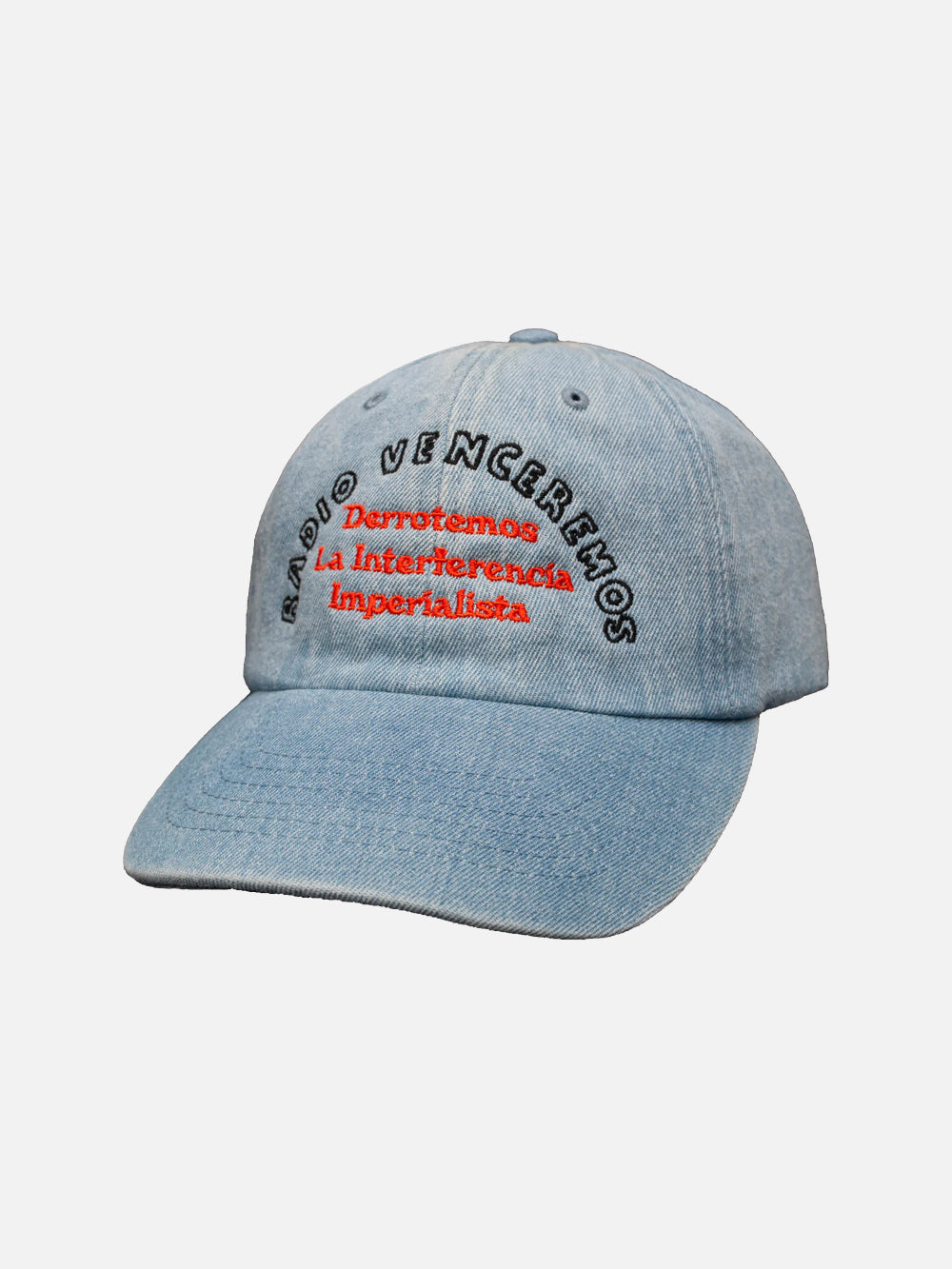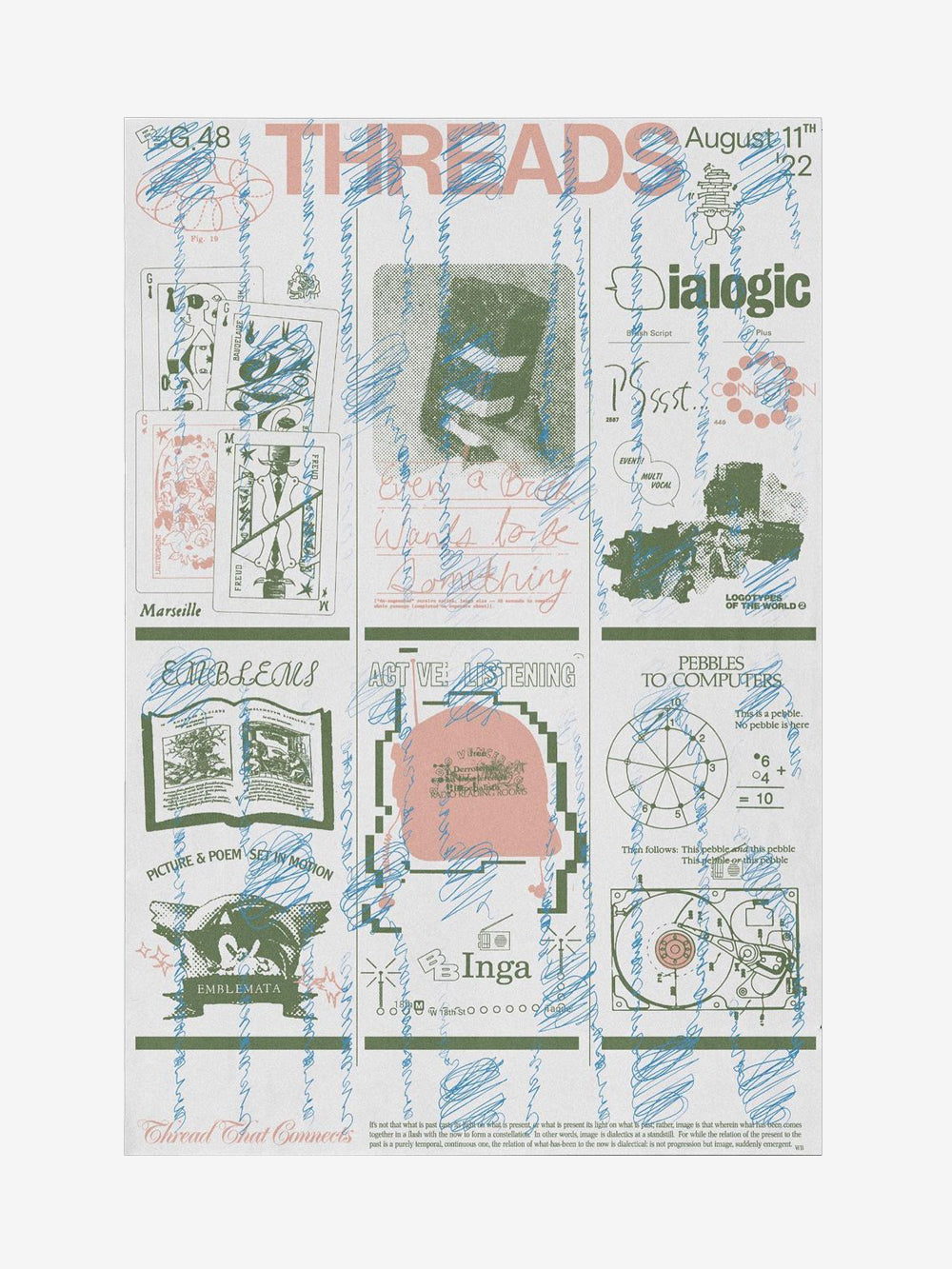



Profits to: Museo de la Palabra y la Imagen
Light Blue Denim Unstructured Hat
Buckled Closer - 100% Cotton
From Boot Boyz Biz:
Radio Venceremos
Radio Venceremos (“Radio We Will Win” or “We Will Overcome”) was a guerilla radio network operated by the Farabundo Martí National Liberation Front (FMLN) during the Salvadoran Civil War from 1981 until 1994. Lasting twelve years, with the Cold War as backdrop, the war was fought between the US-backed Salvadoran government and the FMLN, a coalition of five leftist guerilla organizations. The radio’s daily broadcasts—despite being the constant target of the US-backed Salvadoran armed forces, jamming via North American warships, and frequently forced to change locations—called for support of the worker- and campesino- led struggle and reported on events pertaining to the ongoing war and politics, often times in direct opposition and as interference to official reporting and misinformation surrounding crimes against humanity committed by state forces. The radio provided the circulation of non-manipulated information, a link between combatants, and worked in conjunction with Escuelas Populares and other leftist organizations to establish the framework for crucial and basic community services amidst the struggle.


Santiago, Mariposa, Maravilla and Morena were the pseudonyms of the guerrillas and journalists who primarily devised and produced programming, broadcasting from mobile units which accompanied the advance of the FMLN's insurgent forces. The units were connected by their own internal radio infrastructure, often installed clandestinely in caves and rock formations across El Salvador's Moarazán department, the historic stronghold of the leftist armed struggle movement. The team produced reports, testimonials, debates, radio soap operas, popular education material, and current news. Correspondents visited diary farms, artisanal explosives workshops, school classes, factories, urban and rural labor movements, communal grassroots committees, or narrated surgical operations in FMLN camps.
Under the slogan "Radio Venceremos, voz obrera, campesina y guerillera" ("Radio Venceremos, worker, peasant and guerrilla voice" the radio assumed a role of permanently denouncing the Salvadoran state's trampling of the poor, providing concrete data on the systematic violation of human rights and attracting the attention of international organizations. Radio Venceremos broadcasts, which included listeners across Central, South, and North America, the Caribbean, and at times as far as Europe, fostered the international solidarity movement and became the most reliable medium for the international press. The radio received recognition from the World Union of Journalists when it received the Julius Fučík Award in 1981.


With a lineup of transmitters, amplifiers, tape recorders, diesel generators, and various other pieces of video and audio equipment, the radio broadcast for eleven years—only going off the air for a combined total of nearly one month—all the while subjected to army attacks, aerial bombardment, and the constant requirement to flee. It wasn’t uncommon for live broadcasts to include exchanges of gunfire or explosions as sonic backdrops, all while continuing to provide live reporting. Beyond dedicating its airtime to (the only factual) news reporting, entertainment, or political discourse, the radio’s transmissions were occasionally used to call upon the nation to support the resistance movement through transportation strikes, election boycotts, and armed struggle and uprisings.

"Santiago"
While its twelve year operation was the work of numerous FMLN combatants, Radio Venceremos began initially through the work of Carlos Henríquez Consalvi, alias Santiago, a Venezuelan journalist whose involvement in the Sandinista Revolution in Nicaragua would lead him to connect with revolutionaries in El Salvador. While working as a photographer and journalist, a Sandinista commander asked Consalvi to establish a dual-language Spanish and Miskito radio station. It was while broadcasting in northeastern Nicaragua that Consalvi’s presence was requested in El Salvador, namely through the impetus of the assassination of Archbishop Romero in March of 1980. Another Venezuelan radio operator, Maravilla, made contact with the ERP guerillas in El Salvador and proposed the creation of a clandestine radio station, in enemy territory, with themselves at the helm.

A day after the civil war ended in January 1992, when peace accords were signed by the Salvadoran government and the FMLN in Chapultapec, Mexico City, Santiago departed the guerilla-held Morazán and headed towards the capital city of San Salvador. Alongside other (ex)combattants, and with their transmittion equipment in tow, they approached the city admist scenes of celebration, with thousands of workers, farmers, students, and priests making their way towards the central square of the capital. At 11am, arriving at the plaza, there were multitudes of people and hundreds of flags representing the spectrum of leftist organizations, labor unions, and student movements being waved and hung from buildings—a simple gesture which would have risked the disappearance of someone or provoked the National Guard to open fire (as they often did) days earlier. Consalvi broadcasts in the square, conducting a few impromptu interviews that result in a mix of pure elation and undecipherable chanting. Consalvi and team then climb to the top of the cathedral which overlooks the plaza. After checking their equipment, connecting cables to the audio console, and orientating the antennaes, they began a transmission: “This is Radio Venceremos broadcasting from the heart of San Salvador, from the very same cathedral where Monseñor Romero announced that he would return one day to be among the people.” (Romero was an archbishop killed by security forces during mass, and whose funeral, at the cathedral, saw the armed forces upon fire on civilians). Back in the plaza below, people tune in en masse on their radios to the broadcast, including several radios being broadcast into megaphones. Between echoes and static, the plaza turns into one massive body transmitting the first victorious, post-war broadcast from Radio Venceremos.

Post-war, Consalvi founded the Museo de la Palabra y la Imagen (Museum of the Word and Image) in 1996, with a focus on the preservation of historical memory, cultural history, and post-war reconciliation. The museum’s archive hosts films, photographs, writings, and objects pertaining to the culture and history of El Salvador—including an emphasis on the 1932 peasant uprisings led by the indigenous, communist rebel Farabundo Martí—many of which are otherwise lost outside of the museum’s collection. In 1992 Consalvi published La Terquedad del Izote with the Mexican imprint Editorial Diana, a memoir reconstructed from his (destroyed) notes and diaries recounting the establishing of, operating, and post-war role of Radio Venceremos. Despite being translated into English as "the stubborness of the Izote" (El Salvador's national flower, which can be "reborn out of its own injured trunk" and "never dies"), the book was published in English in 2010 as Broadcasting the Civil War in El Salvador: A Memoir of Guerilla Radio.

Sistema Radio Venceremos
With the help of the journalist Paolo Luers—a German who fought with the Ejército Revolucionario del Pueblo (ERP), a branch of the FMLN—an audiovisual unit semi-independent from the radio was created, called Sistema Radio Venceremos. The multimedia production unit produced documentaries, films, television, photography, silkscreen printed matter, theater, music groups, and publications in part aimed at the American and European public, in part as an archival method, in order to denounce the human rights violations committed by the Armed Forces of El Salvador and publicize the liberation struggle of the FMLN.


"Until now, we have only spoken about the radio station. Radio Venceremos ceased to be only a radio station. It has transformed itself into a system of popular social communication. Today, it uses technical methods to confront imperialism daily on a national and international level in the fields of information and ideological struggle. The construction apparatus for production and circulation of news, the printed word, films, documentary television programs and videos, audiovisual materials, photographic expositions, etc., would not have been possible simply on the basis of the work and sacritice of our people. This work has required, and continues to require, the support and solidarity of other people."

In addition to numerous books and pamphlets, Sistema Radio Venceremos facilitated the production of Señal de Libertad (Signal of Freedom), the “international publication of Radio Venceremos” and the official voice of the FMLN. Señal was edited by the International Command of Information on the Salvadoran Revolution (COMIN), which was headquartered in Mexico City, with satellite locations and support in Köln, West Germany; San Francisco; and Managua, Nicaragua.






Online audio and video archives of the Museo de la Palabra y la Imagen, including several SRV films.
Los Torogoces de Morazán
In 1981, several campesino combattants visit Radio Venceremos and made it known to the team their desire to start a musical group. A mix of poetic lyrics and uncommon speech patterns particular to Morazán, the group recorded two songs with voices, violins, and guitars on the radio's equipment: “Heroic Morazán” and “Radio Venceremos.” While deciding on a name for the group, a pair of multicolored birds with long, beautifully iridescent tails emerge from the holes of an earthen wall next to where the equipment is setup. It was a torogoz (turquoise-browed motmot) nest, the national bird of El Salvador, known for digging trenches for their nests and being generally clever. The name stuck: Los Torogoces de Morazán. Frequently, when the FMLN would occupy a village or reclaim it from armed forces, they would set up equipment to show videos or films in the plaza, invited people to draw murals on public walls, put on puppet shows, and have the Torogoces play.


Operation Trojan Horse
During the course of the civil war, Radio Venceremos achieved a large audience and its transmission operation became the target of constant attacks by the armed forces of the Salvadoran government, who considered its destruction strategic and publicly remarked that it was crucial to a state-led victory. For one military commander in particular, Colonel Domingo Monterossa, every Radio Venceremos broadcast in defiance of state oppression was a demonstration of the legitimacy of the guerrila movement and working class struggle, and Monterossa frequently remarked to the press that he hated Venceremos, and taking down the radio was a personal vendetta for him. Monterossa was the leader of the Atlacatl Battalion, a group of "elite" School of Americas-trained soldiers who were responsible for a large portion of the human rights abuses during the civil war, including the El Mozote massacre in 1981 in which the Salvadoran army killed more than 811 civilians and for which Monterossa gave the order. The sole surviving witness of the massacre, Rufina Amaya, gave her testimony to Radio Venceremos, recounting that the army had killed her husband and her four children (the youngest of whom was eight months old) and had then lit the bodies on fire.


Radio Venceremos played a large role in making cohesive the message and position of the FMLN via its broadcast of international news bulletins to the world. A network of international solidarity organisations, including several operated by Salvadoran guerrillas, academics, or artists in exile in conjunction with the FMLN itself, formed, providing useful fundraising and opportunities for political-diplomatic relations. Both Mexican and French governments officially recognized the FMLN as a result. In an interview with Dirk Kruijt, author of Guerrillas: War & Peace in Central America, Facundo Guardado, an ex- guerrilla and coordinator of the FMLN, estimated that around 80% of the Frente's budget between 1981 and 1991 was obtained via such solidarity organizations:
"Financing was made possible during the initial years—until 1981—as a result of kidnappings. From 1981 until the end of the war, financing was for the most part obtained from organizations—from allied groups all over the world. In Finland, the Netherlands, Sweden, Denmark, France, Germany, the USA— primarily Europe and the USA. This was where we got the money to finance, without exaggerating, at least 80 per cent of the war, from 1981 to 1991. That one German newspaper alone that was called Weapons for El Salvador delivered $3 million to us. That’s why I told you: the political dimension during the entire war also allowed us to receive a certain amount of support that was never in danger of being cut off."
The "weapons for El Salvador" newspaper was "Waffen für El Salvador," the November 3, 1980 frontpage of the Die Tageszeitung newspaper (commonly referred to as taz). Founded in Berlin in 1978 as a cooperative, the politically left-leaning paper raised 4.7 million marks, around $3 million, for the FMLN, which its editors carried in plastic bags in order to hand over to FMLN commanders in either Nicaragua or Mexico via Cuba and East Germany.

Similar solidarity-building movements were present across the world, with political organizations organizing demonstrations, fund-raising drives, producing publications and films, and organizing press conferences in the US (namely San Francisco, Chicago, Washington D.C., and New York), Berlin, Frankfurt, London, and Amsterdam, among other cities.







In June of 1982, a collective of artists and activists named Group Material organized the exhibition ¡LUCHAR! An Exhibition for the People of Central America, which featured the work of numerous Central American artists living in exile in New York City, including the Salvadoran poet and filmmaker Daniel Ascencio Flores. Bridging the work of 27 artist from North and South America, the exhibition included a variety of work, formats, and backgrounds—paintings by recognized artists, posters from the Cuban design collective OSPAAL, and drawings by Nicaraguan children, among other things. At the exhibition's opening, representatives from the FMLN, organizers of the various solidarity organisations from the US involved in the exhibitions launch, and journalists gave press conferences in between performances.



What ¡LUCHAR! started would eventually lead to the founding of Artists’ Call Against US Intervention in Central America, an organized body that would go on to produce 31 exhibitions in addition to poetry readings, film screenings, performances, concerts, and other cultural and politically-aimed educational events. By showing how art making itself could act as a site of activism and a means to establish solidarity networks between the US and Central America, the project was a political statement against a history of US intervention and its oppressive policies and direct support of genocidal regimes across Latin America.




Released in 1991, Contre l'oubli (Against Oblivion a.k.a Lest We Forget) is a film commissioned by Amnesty International, a compilation of 30 short films made by French filmmakers who were asked to use their segment to make a plea on behalf of a political prisoner. Some of the shorts included: Jean Luc Godard and Anne Marie Mieville on the plight of Thomas Wanggai, a West Papuan activist who since died in prison; Jane Birkin's on Maria Nonna Santa Clara, a social worker who was "disappeared" by Philippine security forces in 1989; Costa-Gavras's on Kim Song-man, sentenced to life in prison and tortured in South Korea for "espionage" on behalf of North Korea; Claire Denis' on Ushari Ahmed Mahmoud, a Sudanese political prisoner; and Chantal Akerman's Pour Febe Elisabeth Velasquez, El Salvador—dedicated to Febe Elizabeth Velásquez, a Salvadoran trade unionist and mother of three murdered by the US-backed military junta. In the film, Catherine Deneuve delivers a poem-as-remembrance for Velásquez’s life while cellist Sonia Wieder-Atherton plays a somber piece in the background.




Febe Elizabeth Velásquez was killed when a bomb exploded at the headquarters of the labor federation FENASTRAS in San Salvador, El Salvador, on October 31, 1989. The powerful explosion originated in the building's cafeteria, and claimed the lives of nine unionists, including Velásquez. 27 years-old at the time, Velásquez was the first female Secretary General of FENASTRAS and an internationally recognized leader in Salvadoran social movements. Born in 1962, and often involved in the struggle for a better society, Febe Elizabeth led a 32 day hunger strike in the especially-volatile textile industry. As a result, she was kidnapped in 1986 and released after 5 days of physical and psychological torture. After being released, Velásquez is quoted as saying: “I will continue to fight, because it is just and I do not fear for my life.”
The final of three attempts that same year, the FENASTRAS bombing wasn't unique: that same day, a bomb exploded in the offices of COMADRES, a human rights organization for victim's families, and 16 days later the UCA massacre would take place, where six Jesuit priests, their housekeeper, and her daughter were killed by state forces on the the campus of the Universidad Centroamericana José Simeón Cañas. Partly as a result, the FMLN launched a major offensive in November of 1989 dubbed "Ofensiva fuera los fascistas. Febe Elizabeth vive" ("Offensive to drive out the fascists. Febe Elizabeth lives"), or "ofensiva hasta el tope" ("to the limit" or "to the top" offensive). The most brutal confrontation in the entire armed conflict—amounting for 17 percent of the total casualties in ten years of warfare—the offensive was the only time a guerrilla insurgency has taken control of a capital city. With the offensive including attacks on positions outside of the capital, Radio Venceremos played a central role in consolidating and distributing information and advances across the various fronts. The offensive caused a change in momentum which pushed the Salvadoran state to negotiate with the FMLN, resulting in the 1992 Chapultepec Peace Accords.